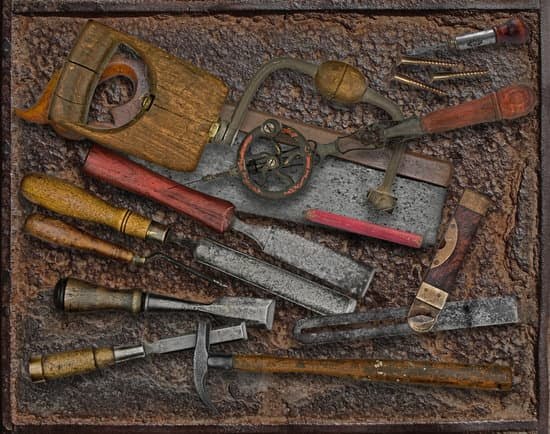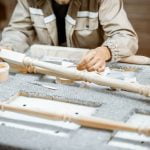Are you a woodworking enthusiast looking to take your craft to the next level? If so, learning how to make a wooden woodworking vise can be a game changer for your projects. A woodworking vise is an essential tool that provides stability and support while working on wood pieces. In this article, we will guide you through the process of understanding, selecting, designing, assembling, and maintaining your very own homemade wooden woodworking vise.
Before diving into the step-by-step instructions for making your own wooden vise, it’s important to understand the key function of this tool. A woodworking vise is designed to securely hold wood in place during cutting, shaping, drilling, or carving.
It acts as an extra set of hands, allowing you to work on your projects with precision and confidence. With a well-crafted wooden vise, you can elevate the quality of your woodworking endeavors and expand your creative possibilities.
Selecting the right type of wood is crucial for ensuring the durability and effectiveness of your homemade woodworking vise. Different types of wood offer varying levels of strength, hardness, and resistance to wear and tear. In the next section, we will explore the best options for wood selection and provide insights into choosing the most suitable material for constructing your vise.
Selecting the Right Type of Wood for Your Vise
When it comes to making a wooden woodworking vise, selecting the right type of wood is crucial to ensure the durability and functionality of your DIY project. The type of wood you choose will impact the overall strength and longevity of your vise, so it’s important to make an informed decision. Here are some options for suitable types of wood that you can consider for your woodworking vise:
1. Hard Maple: Known for its stability and resistance to warping, hard maple is an excellent choice for constructing a sturdy woodworking vise. It is also relatively affordable and readily available, making it a popular choice among DIY enthusiasts.
2. Birch: Another hardwood option, birch offers great strength and durability, making it suitable for crafting a reliable woodworking vise. It is also known for its attractive appearance, adding a touch of aesthetic appeal to your vise.
3. Oak: With its natural toughness and resistance to wear and tear, oak is a dependable choice for building a durable woodworking vise. While it may be slightly more expensive than other types of wood, its superior strength makes it well worth the investment.
No matter which type of wood you ultimately choose for your woodworking vise, be sure to select pieces that are free from knots or defects that could compromise the integrity of your vise. Additionally, consider using hardwoods over softwoods for added strength and longevity.
Gathering the Necessary Tools and Materials
Before you start building your own wooden woodworking vise, it’s essential to gather all the necessary tools and materials that you will need for the project. The good news is that creating a wooden vise doesn’t require specialized or hard-to-find items, making it an accessible DIY project for all skill levels.
First and foremost, you will need to choose the right type of wood for your vise. Select a sturdy hardwood such as oak, maple, or beech, as these types of wood are durable and can withstand the pressure and wear that comes with woodworking projects. You will also need to gather other essential materials like wood screws, wood glue, a steel rod or pipe for the guide bars, and a wooden handle.
In addition to the materials, you will also need several tools to construct your woodworking vise. Some of the essential tools include a saw for cutting the wood to size, a drill with various bits for creating holes, clamps for holding pieces in place during assembly, sandpaper for smoothing out rough edges, and a chisel for fine-tuning any tight fits.
With all these tools and materials on hand, you’ll be well-prepared to move on to the next step of designing and planning your wooden woodworking vise.
Designing and Planning Your Wooden Woodworking Vise
When it comes to designing and planning your wooden woodworking vise, there are a few key considerations to keep in mind. From the size and dimensions of your vise to the type of hardware you’ll need, careful planning is essential for a successful build.
Size and Dimensions
Before diving into the construction process, take some time to determine the size and dimensions of your woodworking vise. Consider the types of projects you’ll be working on and the size of the workpieces you’ll be clamping. Additionally, think about the available space on your workbench to ensure that your vise will fit comfortably without any obstructions.
Type of Hardware
Selecting the appropriate hardware for your wooden vise is crucial for its functionality. This includes choosing the right screws, threaded rods, and other fasteners that will withstand heavy clamping pressure. Be sure to research different types of hardware and their respective load capacities to ensure that your vise can handle any woodworking task.
Custom Features
Another aspect of planning your wooden vise is determining if you want to incorporate any custom features. This could include adding leather or cork facing to the jaws of the vise for added grip and protection, or integrating quick-release mechanisms for efficient operation. Take some time to brainstorm any additional features that could enhance the usability of your woodworking vise.
By carefully considering these factors during the design and planning phase, you’ll set yourself up for success as you move on to assembly and construction. Whether you’re a seasoned woodworker or new to DIY projects, understanding how to make a wooden woodworking vise begins with thoughtful planning and attention to detail.
Step-by-Step Assembly Instructions
Gathering the Necessary Tools and Materials
Before starting the assembly of your wooden woodworking vise, it is important to gather all the necessary tools and materials. You will need wood for the vise jaws and handle, screws or bolts for securing the vise, a drill, saw, screwdriver or wrench, wood glue, and clamps. Make sure to have all these items on hand before beginning the assembly process.
Designing and Planning Your Wooden Woodworking Vise
Once you have gathered all the necessary tools and materials, it’s time to design and plan your wooden woodworking vise. Consider the size of your workbench and the type of woodworking projects you will be working on. Determine the size and dimensions of the vise jaws and handle based on your specific needs. Additionally, consider any custom features you may want to incorporate into your vise design.
Assembling Your Wooden Woodworking Vise
With all your tools, materials, and a solid plan in place, you can now begin assembling your wooden woodworking vise. Start by cutting the wood to size for the vise jaws and handle according to your design specifications. Use clamps to secure the pieces in place before using wood glue to join them together.
Once the glue has set, use screws or bolts to reinforce the joints for added durability. Finally, attach the vise assembly to your workbench according to manufacturer’s instructions or standard mounting procedures.
By following these step-by-step assembly instructions along with careful planning and precision in your woodworking skills, you can successfully create a durable and functional wooden woodworking vise for all your future projects.
Securing and Mounting Your Vise to a Workbench
Once you have completed the assembly of your wooden woodworking vise, the next step is to securely mount it to your workbench. Proper installation is crucial in ensuring that the vise functions effectively and safely. Here’s how to do it:
First, determine the optimal location on your workbench for mounting the vise. It should be positioned at a height and orientation that allows for comfortable usage without compromising stability. Mark the locations where you will drill holes for the mounting hardware.
Next, drill pilot holes in the workbench at the marked locations using a drill bit that corresponds to the size of your mounting hardware. Be sure to measure carefully and use a level to ensure that the mounting holes are straight and even.
After drilling the pilot holes, secure the vise to the workbench using appropriate screws or bolts. Depending on your specific vise design, you may need to use washers or spacers to ensure a tight and secure fit.
Finally, test the vise by firmly clamping a scrap piece of wood in place and applying pressure. The vise should hold the wood securely without any wobbling or shifting. If everything looks good, then congratulations – your wooden woodworking vise is now successfully mounted and ready for use.
| Mounting Process | Details |
|---|---|
| Determine Location | Find an ideal position on workbench |
| Drill Holes | Create pilot holes with proper measurements |
| Secure Vise | Use screws or bolts with washers if needed |
| Test Vise | Ensure sturdiness by clamping scrap wood in place |
Maintenance and Care Tips for Your Wooden Vise
Once you have successfully built your wooden woodworking vise, it is important to maintain and care for it properly to ensure its longevity and optimal performance. One of the most crucial maintenance tasks is keeping the vise clean by removing any sawdust, dirt, or debris that may accumulate on the moving parts. This can be done using a clean, dry cloth or a brush to gently wipe off any build-up.
In addition to keeping your wooden vise clean, it is essential to regularly inspect the vise for any signs of wear and tear. Check for loose screws, cracks in the wood, or any other issues that may affect the functionality of the vise. If you notice any problems, address them immediately to prevent further damage and ensure that your vise continues to work effectively.
Proper lubrication is also key to maintaining a wooden woodworking vise. Apply a small amount of wax or specialized woodworking lubricant to the moving parts of the vise to keep them operating smoothly without friction. This will prevent unnecessary strain on the vise and prolong its lifespan.
| Maintenance Task | Details |
|---|---|
| Cleaning | Regularly remove sawdust and debris with a dry cloth or brush. |
| Inspection | Check for loose screws, cracks, or other issues that may affect performance. |
| Lubrication | Apply a small amount of wax or woodworking lubricant to moving parts for smooth operation. |
Troubleshooting Common Issues With Your Homemade Vise
In conclusion, making a wooden woodworking vise can be a fulfilling and rewarding project for any woodworker. By understanding the function of a woodworking vise and selecting the right type of wood for your vise, you can ensure that the end product is sturdy and durable. Additionally, gathering the necessary tools and materials, as well as designing and planning your vise, are important steps in the process.
Following step-by-step assembly instructions and properly securing and mounting your vise to a workbench are crucial to its functionality. Furthermore, maintaining and caring for your wooden vise will help prolong its lifespan and ensure that it remains in good working condition. By troubleshooting common issues with your homemade vise, you can address any minor problems that may arise and continue to use it effectively for all your woodworking projects.
In summary, learning how to make a wooden woodworking vise allows you to customize a tool specifically tailored to your needs as a woodworker. With patience and attention to detail, you can create a high-quality vise that enhances the precision and quality of your woodworking projects. Whether you are a seasoned woodworker or just starting out, building your own wooden vise is an enriching experience that adds value to your craft.
Frequently Asked Questions
What Is the Best Wood for a Woodworking Vise?
The best wood for a woodworking vise is hardwood, such as maple, beech, or oak. These types of wood are durable and can withstand the pressure and wear and tear that comes with clamping and securing wood during woodworking projects.
What Is the Difference Between a Woodworking Vise and a Metal Vice?
The main difference between a woodworking vise and a metal vice is the material they are made of and their intended use. A woodworking vise is typically made of wood or has wooden jaws, designed specifically for holding wood in place during tasks like sawing, drilling, or sanding.
A metal vice, on the other hand, is made of metal and is generally used for securing metal pieces for cutting, drilling, or shaping.
What Size Vise Do I Need for Woodworking?
The size of the vise needed for woodworking depends on the scale of your projects and the size of the materials you will be working with. For most general woodworking tasks, a medium-sized vise with jaw width around 7-10 inches should suffice.
However, larger projects may require a larger vise to accommodate bigger pieces of wood. It’s important to consider the size of your workbench as well when determining the appropriate size vise for your woodworking needs.

Hi everyone! I’m a woodworker and blogger, and this is my woodworking blog. In my blog, I share tips and tricks for woodworkers of all skill levels, as well as project ideas that you can try yourself.





